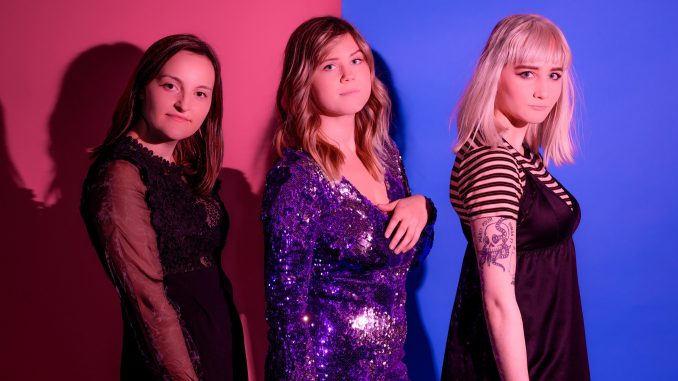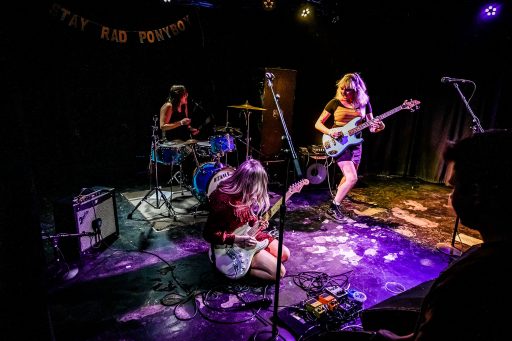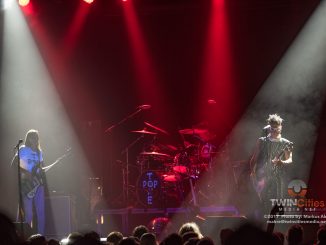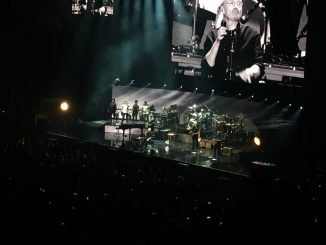
Few young bands in the crowded Twin Cities music scene are working harder or making more progress than the all-female pop punk band Last Import. Twin Cities Media sat down with drummer and founding member Jane Halldorson over kiddy cocktails at The Depot to catch up with what’s in store for her and band mates Emily Bjorke and Grace Baldwin. Our conversation rambled over ground about the challenges of being financially viable, the listening habits of Millennials and the need to find creative ways to break out of the ranks of the ubiquitous DIY, rock n roll wannabes.
Unless you’ve been sleeping under a rock, it’s been difficult not to be aware of this band. In addition to a sold-out release party at The Entry back in February, the past year has seen Last Import on The Mainroom and Palace stages. Impressive stuff for three college age musicians who joined forces five years ago and cut their teeth at Burnsville’s band incubator, The Garage. What began as a project comprised of little more than attitude, determination and desire, Last Import has morphed into a legit band poised to launch its first East Coast tour in June.
The topic I was most interested to explore with Halldorson was a unique project planned during the tour. It is an effort to move the band into the prohibitively expensive world of vinyl and to merge that effort with what has become the financial life line of most touring bands: merch. Is it any wonder we are always invited to stop by the merch table following a show to meet the band? And, hopefully, buy some stuff.
The details of that exciting idea can be found at the bottom of this article. It’s time sensitive. So, if you haven’t the time to read your way to the end, just skip everything and check it out.
How many club goers fully appreciate how poorly most working bands are paid? When you factor in the hours of practice, miles on the road hauling gear and performing their music, rarely do they earn minimum wage. Young bands rely on the occasional gig with a budget; opportunities like college gigs, summer festivals or the private party of a well-heeled fan. And anything they can sell which helps create a brand that audience members want to wear or own.
Vinyl has become the new “must have” for young music fans. The trick is how to provide that opportunity to fans in a manner that’s financially solvent. Records are expensive. Most minimum runs for vinyl are generally about 500 units. Production costs will run in the $2500 to $3000 range for that number of units. That’s on top of studio costs, mixing and mastering which can effectively double the cost. That’s no problem for a record label. But it often becomes an insurmountable hurdle for any band looking to move from potential to full time professional.
Halldorson is a self-described vinyl junkie (who else works in a record shop?) We discussed how the recording and distribution worlds have come full circle. As someone who was buying records during that first seismic shift from 45 rpm to full length album (yes, our first turntables featured a 78 rpm option because there was no shortage of this earliest format lying around our parents’ home), it proved an interesting conversation. We came at it from opposite ends of the spectrum.
It’s a given that the days of CD’s are coming to an end. Streaming services like Spotify, Google or Apple Music have become the dominant method of distribution. But it’s a dangerous and double-edged sword.
It’s hard not to appreciate the ability to access literally any music, any band, with the tap of your phone screen. Used as a resource like the Library of Congress, it is incredibly valuable. But there are numerous downsides to the convenience.
First, artists need to eat. The payout rate for a Spotify stream amounts to less than one half of 1 penny. Do the math. If you hit 100,000 times people listen to your song, you’re in line to receive round $500. Split three ways in a band, it’s not about to pay the rent.
Second, the best music fans are curious. They take pride in exploring their own paths through the jungle. They aren’t looking for a map. They are looking to create their own maps which others are welcome to follow. The problem is that most of us are basically lazy. Streaming services provide a convenient crutch by allowing some type of AI algorithm or influential playlist maker to determine what we should hear next.
Consider the conundrum for bands trying to find new people to listen to their music. If you try to be unique, by definition, you’re not “like” something else. So, your chances of an algorithm or taste maker including you on a popular playlist are poor. If you want to be heard, you are under pressure to stay within some semblance of an identifiable 9 dots. What kind of environment is that for any creative art form?
Halldorson described her excitement whenever she had the opportunity to flip through used record bins. Her sense of exploration; risk vs return. The thrill of picking up a record from an unknown band but connecting with the artwork or liner notes. Of taking it home and putting it on the platter. Cracking it open like a geode. Hoping for that crystal that takes your breath away. What The Posies Ken Stringfellow described as playing Record Store Roulette. In Jane’s case, she said the frequency and intensity of the big score was more than enough to keep her addicted.
I was struck by the similarity of her description to a conversation I’d had just six days earlier while down at SXSW in Austin. Through a set of fortuitous circumstances, I was able to finally meet and share coffee with one of the truly great bass players of the modern era. Sarah Brown has enjoyed a Blues Hall of Fame career playing with literally everybody. Artists like Big Walter Horton, the brothers Vaughn Jimmy and Stevie Ray, Marcia Ball, Dave Alvin. Buddy Guy and Gary Clark, Jr, to name a few. Years of being part of Antones’ famous house band will do that for you.
In our conversation, she reminisced about trolling through those Goodwill record bins. Searching for that gem that none of your friends had. Laying her hands on that early, limited run Ray Charles. The kind of record with one deep cut you could learn before anybody else in your circle of friends.
Forty five years may separate these two women. Literally two generations. Yet a kindred spirit connects them. No direct Obi Wan and Anakin, this. Simply two people, who will likely never cross paths, both wired into The Force. Those of us who are so wired, know what that means. We’re the ones who grow seriously irritated when we cue up a record and the person who should be listening is chattering on about their day.
A funny story once told by my brother serves as illustration. He and his teenage son were sitting in the family room listening to The Hold Steady’s Lord, I’m Discouraged. His spouse entered the room and attempted to engage them in a conversation. When the song ended, he looked at her and said: “Honey, we have a rule in this house. No talking over a shredding guitar solo.” She looked at him perplexed and asked: “What guitar solo?” Like I said, either you’re in tune with The Force or you ain’t.
But back to the point before that gratuitous tangent. Vinyl records are fundamentally different from our other listening platform options. Part of the resurgence of vinyl is that direct connection to the artist. You hold in your hands a physical artifact. It’s collectible. It’s no different from the compulsion to collect fine art for your home. Or coins. Or stamps. Or agates. Unlike the casual Spotify grazer, the art is kept, maintained and treasured rather than consumed and discarded.
Don’t most artists prefer the concept of leaving something behind for generations to come? Isn’t that a higher calling than simply producing something which will be consigned to the back end of a burgeoning digital catalog?
So, no question that many artists love vinyl. (Note that one of the first questions Sarah Brown asked me last week was whether I’d had an opportunity to visit Antones’ record shop, tucked in an alcove beside the entrance? Yes, of course!) No question that serious music fans appreciate the concept of collecting the artifact. To many of my generation, it’s always been about even more. It’s about sonic integrity. No digital format provides the openness, completeness and warmth of vinyl.
The modern MP3 is designed to take advantage of the human brain’s remarkable ability to fill in gaps to complete a picture. That MP3 signal contains only 1/13th of what the artist recorded. It’s all that’s necessary for our brains to recognize a pattern and to instinctively fill in the holes. The question becomes how good is my patching material?
Couple that stripped signal with both what my phone can produce and the air movement and accuracy of a cheap earbud. Yes, it’s the song and I recognize it. But nobody ever got comfy in an elevator to listen to the tunes. It’s bewildering to many of us why we settle for the same for the sake of an unlimited library and convenience. We would never consider visiting the Louvre without remembering our glasses. Sure, I could tell it was a Monet. But I’d never appreciate the brush strokes.
Good records were conceived to do just the opposite of what streaming services do. Provide a breathing record of a particular band, in a particular place, at a particular point in time. How else to explain the stereo system arms race that dominated the 1970’s when the LP took the world by storm? It was a concerted effort to develop a delivery system which could literally bring the band directly into your living room.
Jane was quick to point out another more modern side of this equation. Unlike us old guys, who pick up an album to listen on the best stereo systems we can buy, much of today’s new generation of vinyl buyers is comprised of what she refers to as musical hipsters. Yes, they buy albums and wouldn’t be caught dead with a CD player. But the driving force is the desire to be part of a cooler group. About being more sophisticated than the rabble. It’s more about the social cache’ than the sonic Easter eggs. Following a show, vinyl is the souvenir du jour.
Jane shook her head and told me: “People will come into the store and they’ve got to immediately lay their hands on the new Jay Z. That’s fine, I guess. But sometimes I want to shake them and tell them they can find 4 or 5 albums over in that used bin for the same price. And no disrespect to Jay Z, the music is better!”
But that’s ok. Because the artist has left a physical legacy in the hands of the fan. Even if the purchase motivation was fashion and not musical passion, somebody, somewhere down the line may very well pluck that piece of art trolling through Sarah Brown’s Goodwill bin. Once more the songs will live and take somebody’s breath away with the discovery.

I began this article by mentioning how hard Last Import has worked at marketing their band. How they’ve managed to do such a credible job of remaining financially viable against tremendous odds. It’s no wonder that an addiction to vinyl, a desire to be remembered, a plan to deliver to fans exactly what they want, has led the band to a wholly original and worthwhile idea.
While on their summer tour, the band will spend a day in New York City’s Leesta Vall Studios. There they will record individual, one of a kind, direct to vinyl 7-inch records for specific fans. If you’re one of those who loves the idea of owning a record nobody else on your block has, this is that concept on steroids!
All records must be pre-ordered. Each person ordering gets to choose from a menu of Last Import songs. Your record will begin with a dedication to you or to whomever you are gifting the record. The ladies will then record the song in a single live take. Nobody else will own that particular version. Absolutely unique. The ultimate band artifact.
Jane laughed and indicated it’s the flaws and immediacy which make this so appealing. “They’ll get us just as we are in that moment. If we make a mistake, we make a mistake. But it will be your mistake. Other people can have their own mistakes!”
I stopped for a moment to consider the logistics to pull off a project like this in terms of time. It’s going to be a grueling day for even the toughest road dogs. Let’s assume the average length of a dedication and song is 4 or 5 minutes. The re-set time between takes is another 4 or 5 minutes. You’re talking nearly 10 minutes for each and every record. A 10-hour work day contains a grand total of 600 minutes. So even if you minimally factor in the need to grab a drink, a bite to eat or a chance to head for the bathroom, the maximum output is only about 50 individual recordings.
Hell, even the Grateful Dead wouldn’t have attempted to play straight for 10 hours! “One thing for sure,” said Jane, “we will walk in there ready to go. And you can bet that as we record a song over and over again, it’s going to get really tight. Some of those takes are going to catch lightning in a bottle. We’re really excited by that.”
How can you grab a piece of this history for yourself or the coolest birthday or Christmas present for that special friend? You move FAST! These records are going to be extremely limited. Despite just announcing the project, about half have already been snapped up. By the time this article is published, that number will be even smaller. If you delay you will lose the opportunity. You can find it HERE
Jane and I laughed about Minnesotans being the world’s greatest procrastinators. “I don’t get it!” she said, “When a show I want to see announces, I buy my tickets immediately. I can’t understand people who get shut out of a sold-out show and then complain. You had your chance! Why did you sit on your hands?”
Each one of a kind 7-inch is $25 and, as previously stated, they must be pre-ordered through the link provided. Jane was willing to explain how those dollars are distributed. Last Import receives $10 for each record. $10 goes to the studio. $5 covers the individual pressing, packaging and shipping. Nobody is getting rich. But it’s a virtuous circle that blows the doors off that streaming service you’re listening to through cheap earbuds.
The wheel of history always turns and, in many respects, repeats itself. We witness that as once again records sales rise and the price of refurbished vintage stereo gear skyrockets. I also see a resurgence of great young rock bands popping up all over the Twin Cities. Just like the early 80’s, before big labels and big money effectively wrecked the scene, bands like Suicide Commandos, Husker Du, Babes in Toyland, The Suburbs, The Replacements and Soul Asylum were sharing resources and helping each other along. Inspired more by being rockers than becoming stars.
Hang around the scene these days and you can see that percolating again. It’s an exciting time to be a local music fan. In a few years, a handful of these bands will have broken out in a meaningful way. The best ones will have done it just the way those earlier Twin Cities bands did. By fighting for every last fan, never giving up and helping each other survive.
Whatever becomes of Last Import, today they are in the modern vanguard. They deserve our thanks and support for helping pave the way.




